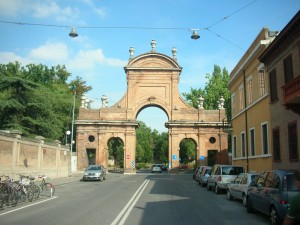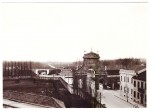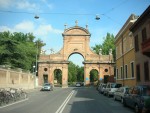Prospettiva di Corso Giovecca

Prospettiva di Corso Giovecca, before the earthquake. Photo by Francesco Scafuri. Image from Cronaca Comune, https://www.cronacacomune.it/notizie/24973/prospettiva-corso-giovecca-recupero.html
The triumphal arch that separates Corso Giovecca from Piazza Medaglie d’Oro was designed and erected by Francesco Mazzarelli between 1703 and 1704. It has been altered over the years, until taking on its present-day appearance, which is mainly due to the widening of the road and the creation of Piazza Medaglie d’Oro in the late 1930s.
Name and brief history
Designed by an architect named Francesco Mazzarelli, the triumphal arch found at the end of Corso Giovecca, where it meets Piazza Medaglie d’Oro, was built between 22 October 1703 and 27 June 1704, thanks to the support of the Municipality. It originally had three arches and was decorated by marble coats of arms. The original design, including the coats of arms of the pope, the legate and the Giudice dei Savi (Judge of the Sages, who was Carlo Fiaschi at the time), was changed by the designer as it was being built, adopting the indications of the Judge of the Sages, who requested that the coats of arms of the nine Savi del Maestrato (Sages of the Magestrate be added. This second design included octagonal commemorative plaques located above the lateral arches (which some scholars believe were destroyed in the late eighteenth century under French occupation), a different layout of the statues of Saint George and Saint Maurelius, which effectively were never installed, and the ornamental pinnacles for greater height. Once completed, Mazzarelli himself described it as a triumphal arch with Tuscan order columns, divided into three archways.
The less drastic changes implemented in the nineteenth century were paired with more substantial ones in the early twentieth century, modifying the original appearance of the Prospettiva di Corso Giovecca, while reconfirming its status the as one of the main monuments of Ferrara. With the widening of the street and the design and implementation of the city plan that created Piazza Medaglie d’Oro, which the Municipality worked on from the late 1930s onwards, the triumphal arch was expanded by adding two lateral openings, for pedestrian use, each topped with its own pinnacles.
Similar to the Prospettiva della Ghiara, built at the end of Via XX Settembre by architect Gaetano Genta in 1776, the main scope of the Prospettiva di Corso Giovecca is to 'set the stage’. In other words, when travelling outwards, it acts as a ‘final vanishing point for the street, which became an entry gate to a different kind of city, that is, to the land of the Delizie, to luxuriant gardens’ (C. Bassi, Nuova Guida di Ferrara. Vita e Spazio nell’Architettura di una Città Emblematica, Italo Bovolenta editore, Ferrara 1981 p. 246). Likewise, heading inwards, it allowed for the entry into the heart of the city through one of its main avenues. In addition to this historical role, it also allows for the entry and exit of people and goods to be managed.
The earthquake that struck Emilia in 2012 made it necessary to temporarily remove the pinnacles along the top, which were cleaned and newly affixed with special earthquake-proof plates in December 2015.
In literature
The triumphal arch in Corso Giovecca appears in one of Giorgio Bassani's poetic works, capable of reinstating the entire view of the avenue (as already was the case in the very beginning of the tale titled The Walk Before Supper), with the gate that seems to get larger heading towards and coming from the castle. The work is in fact Rolls Royce, one of Bassani's most admired lyric poems for its effectiveness in conveying the feeling of exile. Unlike the narrative piece, the aspect portrayed in verse is much more intimate and clearly references the autobiographical experience of the author, restored by Bassani through an overlapping of real visual information with an imaginative transformation drawn upon from memory and by intense nostalgia, which turns the past into a present that is very much alive.
In addition, in Bassani's novel The Heron, the Prospettiva di Corso Giovecca is a threshold between Ferrara and the familial, more external side of the protagonist, Edgardo Limentani, and his deeper, subconscious, more personal side, corresponding to the hazy, damp elsewhere of Codigoro and its surroundings (G. Bassani, L’airone, in Opere, Il Romanzo di Ferrara, p. 726 and 840).
Quotes
Rolls Royce Immediately after having closed my eyes forever, here I am once again, who knows how, recrossing Ferrara by car - an immense metallic-coloured foreign made limousine with wide murky windows, perhaps a Rolls Royce- Driving once more down from the Este castle along Giovecca Avenue towards the rose-coloured arabesque on the end of the Prospettiva that in the meantime slowly but surely came into focus within the concave rectangle of the windshield His neck long and stiff the chauffeur, seated in front on the right, certainly knew very well which way to go, and I, on the other hand, wouldn’t have even dreamed of telling him anxious as I was to recognize, on the left, the church of Saint Charles, further on the right the Theatine one already standing together chatting so early in the morning on the sidewalk in front of the Folchini pastry shop my father’s friends when he was young most of them with broad grey Homburg hats, some flashing silver-handled walking sticks in their fists anxious actually eager as I was in short to retrace all of Main Street of my city in a day of almost May-June around the mid-Twenties a quarter of an hour before nine in the morning Almost pushed by its own luxurious murmur finally the Rolls turned down Via Madama and just after at Via Cisterna del Follo and at that point I was no more than ten cheeks burning for fear of being late to school leaving at that precise moment with books under arm from door number one it was I who, while continuing to run, was turning back at my mother leaning out the upstairs window reminding me of something it was I, really me, who, an instant before disappearing around the corner, from my young mother's sight waved my left hand in a gesture of both impatience and goodbye I would have liked to have cried ‘halt’ to the stiff chauffeur and to have gotten out, but the Rolls Royce, lurching gently, was already passing the Montagnone, was even beyond, already outside the gate, already down wide deserted streets completely void of roofs on either side and completely unknown (G. Bassani, Rolls Royce and Other Poems, translated by Francesca Valente, Greg Gatenby, and Irving Layton, Toronto, Aya Press, 1982, p. 11)
Bibliography
- Carlo Bassi, Nuova guida di Ferrara. Vita e spazio nell’architettura di una città emblematica, Italo Bovolenta editore, Ferrara 1981
- Giorgio Bassani, Lida Mantovani in Opere, Il romanzo di Ferrara, Mondadori 2001
- Giorgio Bassani, Opere, In rima e senza, Mondadori 2001
- Melchiorri, Gerolamo, Bassi, Carlo, Nomenclatura ed etimologia delle piazze e strade di Ferrara. Ampliamenti all'opera di Gerolamo Melchiorri, 2G, Ferrara 2009
- Antonio Zanoletti, Origine e vicende della Prospettiva di Corso Giovecca in Atti e memorie, 2, Vol. 2, 1944
Sitography
Fototeca
Compiling entity
- Assessorato alla Cultura e al Turismo, Comune di Ferrara
Author
- Barbara Pizzo




